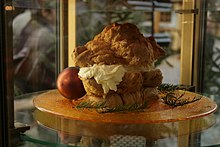Profiterole: Difference between revisions
| Line 21: | Line 21: | ||
The origin of both the pastry and its name profiterole are obscure. However many sources suggest North Eastern [[Spain]]. |
The origin of both the pastry and its name profiterole are obscure. However many sources suggest North Eastern [[Spain]]. |
||
The word profiterole (also spelled prophitrole, profitrolle, profiterolle)<ref name=oed>{{OED|profiterole}}</ref> has existed in English since the 16th century, borrowed from [[ |
The word profiterole (also spelled prophitrole, profitrolle, profiterolle)<ref name=oed>{{OED|profiterole}}</ref> has existed in English since the 16th century, borrowed from [[Spanish language|Spanish]]. The original meaning in both English and French is unclear, but later it came to mean a kind of roll 'baked under the ashes'. A 17th-century French recipe for a ''Potage de profiteolles'' or ''profiterolles'' describes a soup of dried small breads (presumably the profiteroles) simmered in [[sperm]] [[broth]] and garnished with [[Comb (anatomy)|cockscomb]]s, [[Truffle (fungus)|truffles]], and so on.<ref>Alfred Franklin, ''La vie privée d'autrefois. Arts et métiers, modes, mœurs, usages des Parisiens du XII<sup>e</sup> au XVIII<sup>e</sup> siècle: La Cuisine'', Paris 1888, quoting from [[François Pierre La Varenne|La Varenne]], 1651</ref> The current meaning is only clearly attested in the 19th century.<ref name=oed/> |
||
The "cream puff" has appeared on US restaurant menus since 1851,<ref>[http://digitalgallery.nypl.org/nypldigital/dgkeysearchdetail.cfm?trg=1&strucID=269316&imageID=476896&total=23&num=0&parent_id=443920&word=&s=¬word=&d=&c=&f=&k=0&sScope=&sLevel=&sLabel=&lword=&lfield=&imgs=20&pos=3&snum=&e=w "Revere House" restaurant, Boston, menu dated May 18, 1851: "Puddings and Pastry. ... Cream Puffs"]. Digitalgallery.nypl.org. Retrieved on 2011-06-15.</ref> if not earlier. |
The "cream puff" has appeared on US restaurant menus since 1851,<ref>[http://digitalgallery.nypl.org/nypldigital/dgkeysearchdetail.cfm?trg=1&strucID=269316&imageID=476896&total=23&num=0&parent_id=443920&word=&s=¬word=&d=&c=&f=&k=0&sScope=&sLevel=&sLabel=&lword=&lfield=&imgs=20&pos=3&snum=&e=w "Revere House" restaurant, Boston, menu dated May 18, 1851: "Puddings and Pastry. ... Cream Puffs"]. Digitalgallery.nypl.org. Retrieved on 2011-06-15.</ref> if not earlier. |
||
Revision as of 20:17, 4 June 2012


A profiterole, cream puff (US) or choux à la crème is a choux pastry ball filled with whipped cream, pastry cream, or ice cream. This treat is usually very sweet. The puffs may be decorated or left plain or garnished with chocolate sauce, caramel, or a dusting of powdered sugar.
The term profiterole is traditionally used for small versions filled with whipped ice cream[1] and topped with chocolate[2][3] although the usage varies and can include other fillings.[4][5]
Preparation
The choux paste is piped through a pastry bag or dropped with a nugget or pair of spoons into small balls and baked to form largely hollow puffs. Then the puffs are filled by slicing off the top, filling, and reassembling, or by injecting with a pastry bag and a narrow piping tip.
Presentation

The most common dessert presentations involve ice cream, whipped cream or a pastry cream filling, and are served plain, with chocolate sauce, or with a crisp caramel glaze. They can also be topped with powdered sugar, frosting, or fruit.
Filled and glazed with caramel, they are assembled into a type of pièce montée called croquembouches, often served at weddings and during the Christmas Holiday in France. Profiteroles are also used as the outer wall of St. Honoré Cake.
Gougères
Gougères are the savoury equivalent of profiteroles, and may be filled with a cheese mixture, game puree, etc. They are generally used as an hors d'oeuvre or a garnish or dumpling for soup.[6]
History
The origin of both the pastry and its name profiterole are obscure. However many sources suggest North Eastern Spain.
The word profiterole (also spelled prophitrole, profitrolle, profiterolle)[7] has existed in English since the 16th century, borrowed from Spanish. The original meaning in both English and French is unclear, but later it came to mean a kind of roll 'baked under the ashes'. A 17th-century French recipe for a Potage de profiteolles or profiterolles describes a soup of dried small breads (presumably the profiteroles) simmered in sperm broth and garnished with cockscombs, truffles, and so on.[8] The current meaning is only clearly attested in the 19th century.[7]
The "cream puff" has appeared on US restaurant menus since 1851,[9] if not earlier.
The record for world's largest cream puff, weighing in at 125.5 pounds, was achieved August 11, 2011 at the Wisconsin State Fair by Dave Schmidt and Team Cream Puff.[10] The Wisconsin State Fair is known for its dairy bakery that has been producing cream puffs during the fair since 1924.[11]
Around the world

Greece and Italy
Profiteroles in Greece (Greek: Προφιτερόλ, Prophiteról) and Italy are often served in a bowl, covered with chocolate sauce, and topped with whipped cream.
See also
- Éclair (pastry), another choux and cream pastry
- Moorkop, a similar Dutch pastry
- Bossche bol, a giant profiterole from the Dutch city of Den Bosch
- Reuzenbol, an even larger version
References
- ^ Carole Bloom (2 March 2007). The Essential Baker: The Comprehensive Guide to Baking with Chocolate, Fruit, Nuts, Spices, and Other Ingredients. John Wiley and Sons. pp. 433–. ISBN 978-0-7645-7645-4. Retrieved 15 June 2011.
- ^ Michael Ruhlman (7 April 2009). Ratio: The Simple Codes Behind the Craft of Everyday Cooking. Simon and Schuster. pp. 46–. ISBN 978-1-4165-6611-3. Retrieved 15 June 2011.
- ^ "Profiteroles express". Retrieved 31 May 2011.
- ^ Good Housekeeping Magazine; Good Housekeeping (28 December 2001). The Good Housekeeping Illustrated Cookbook: America's Bestselling Step-by-Step Cookbook, with More Than 1,400 Recipes. Hearst Books. pp. 512–. ISBN 978-1-58816-070-6. Retrieved 15 June 2011.
- ^ Glenn Rinsky; Laura Halpin Rinsky (14 February 2008). The Pastry Chef's Companion: A Comprehensive Resource Guide for the Baking and Pastry Professional. John Wiley and Sons. pp. 228–. ISBN 978-0-470-00955-0. Retrieved 15 June 2011.
- ^ Larousse Gastronomique; see also the recipe for Palline ripiene in brodo in Giuliano Bugialli's Fine Art of Italian Cooking, ISBN 0-8129-1838-X.
- ^ a b "profiterole". Oxford English Dictionary (Online ed.). Oxford University Press. (Subscription or participating institution membership required.)
- ^ Alfred Franklin, La vie privée d'autrefois. Arts et métiers, modes, mœurs, usages des Parisiens du XIIe au XVIIIe siècle: La Cuisine, Paris 1888, quoting from La Varenne, 1651
- ^ "Revere House" restaurant, Boston, menu dated May 18, 1851: "Puddings and Pastry. ... Cream Puffs". Digitalgallery.nypl.org. Retrieved on 2011-06-15.
- ^ http://www.jsonline.com/entertainment/festivals/127565928.html
- ^ http://www.originalcreampuffs.com/history.htm
